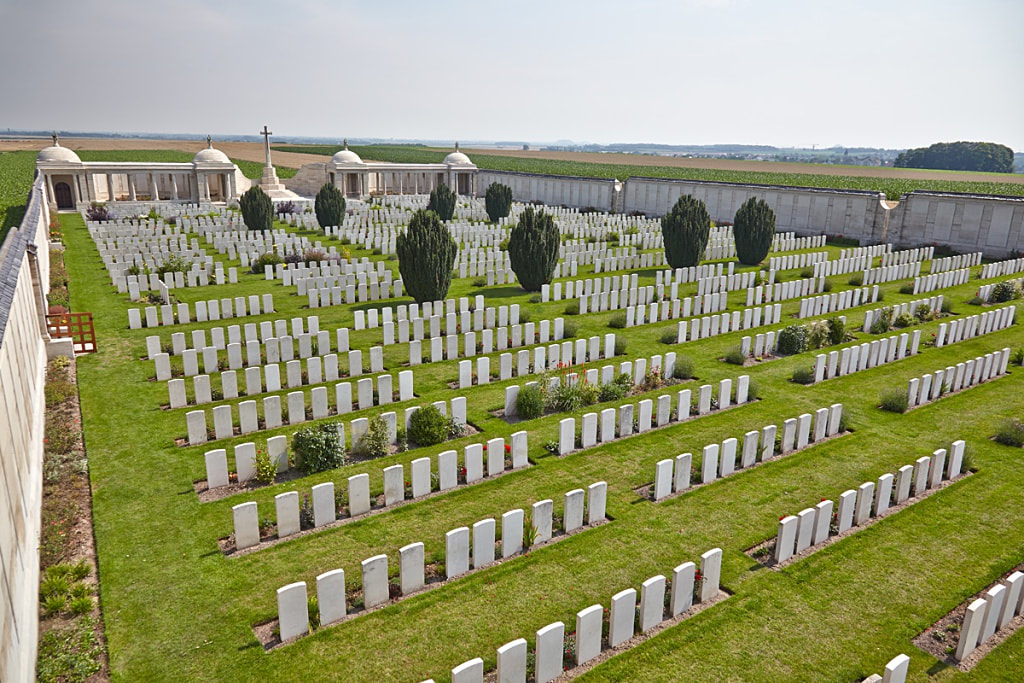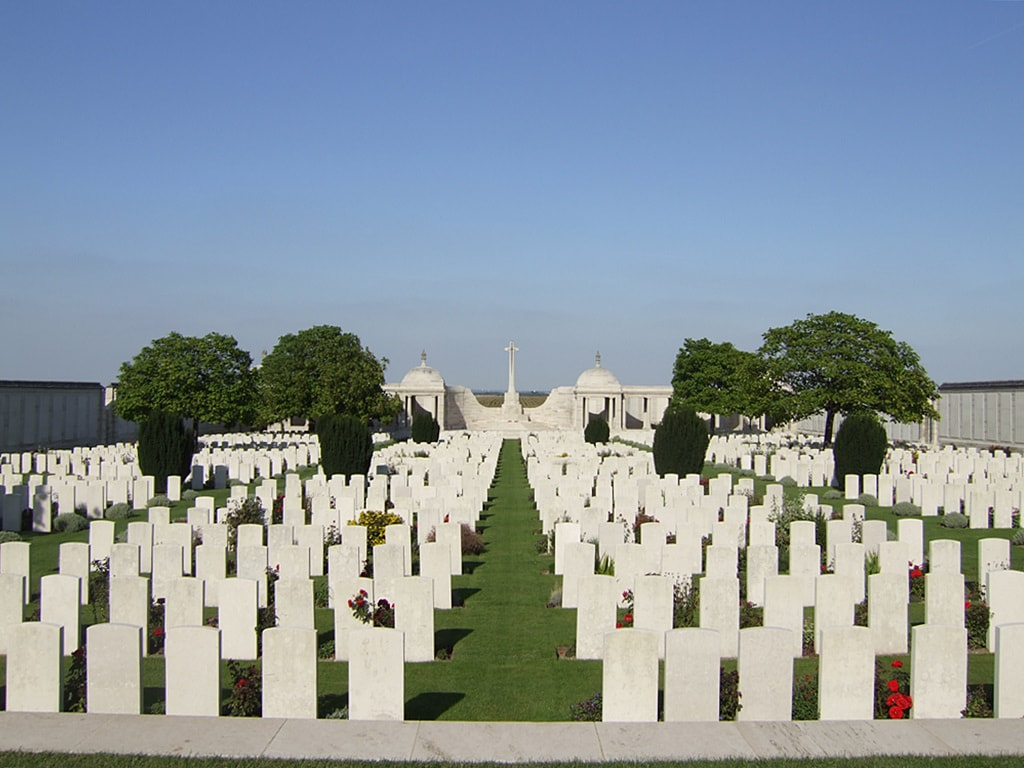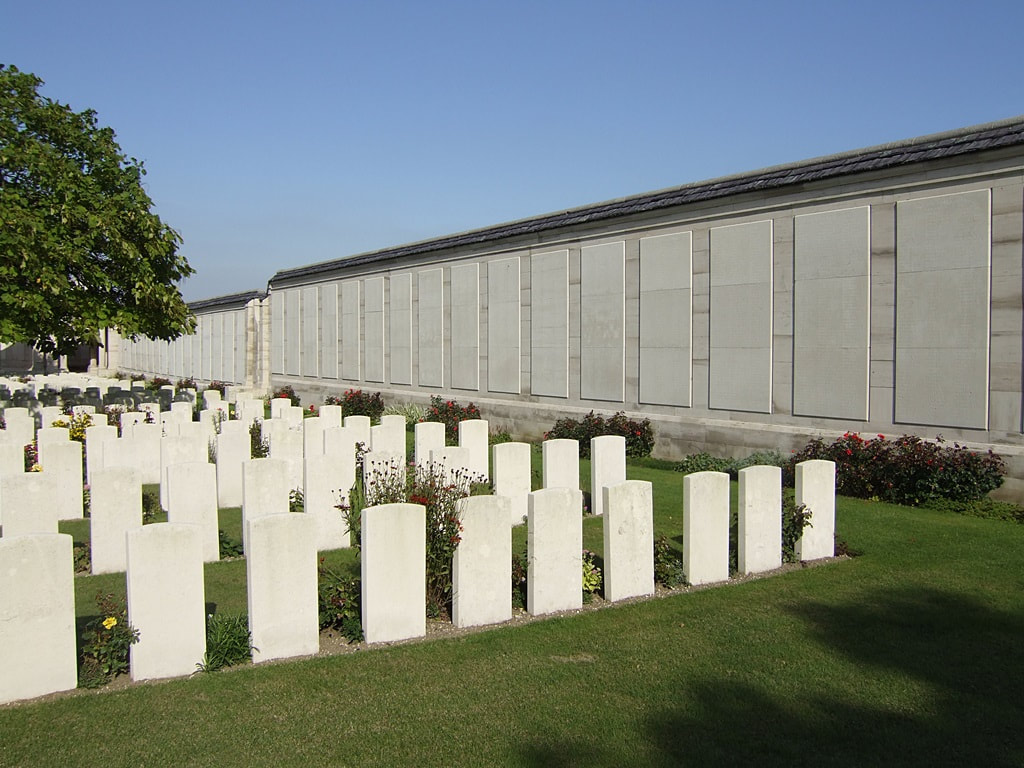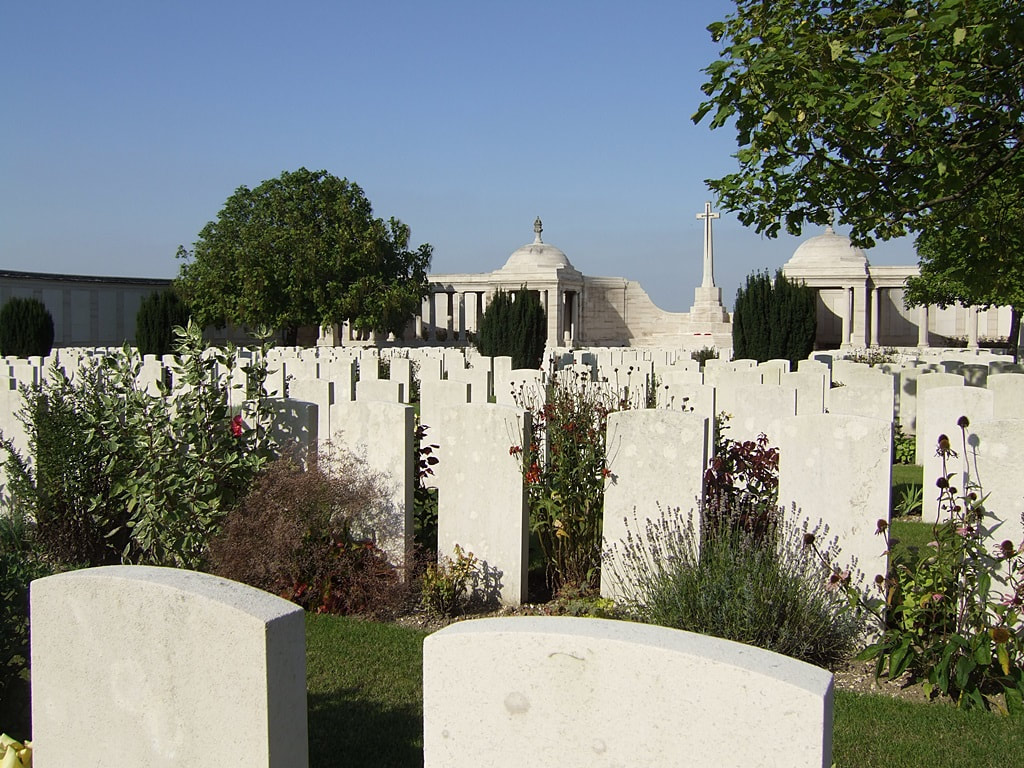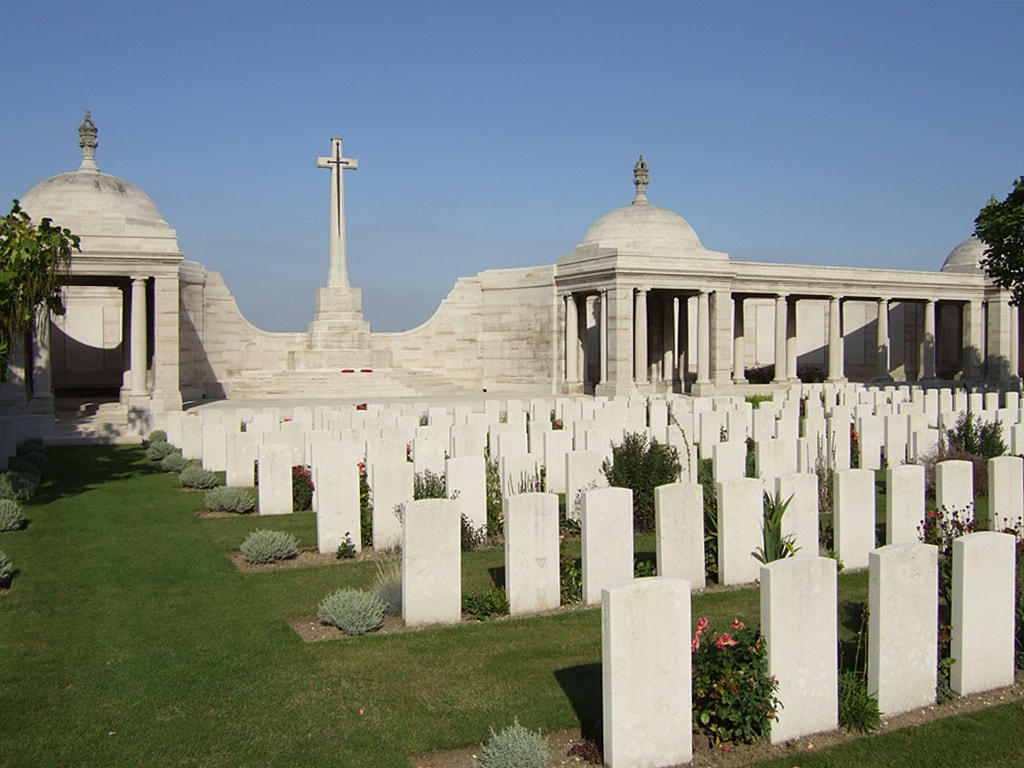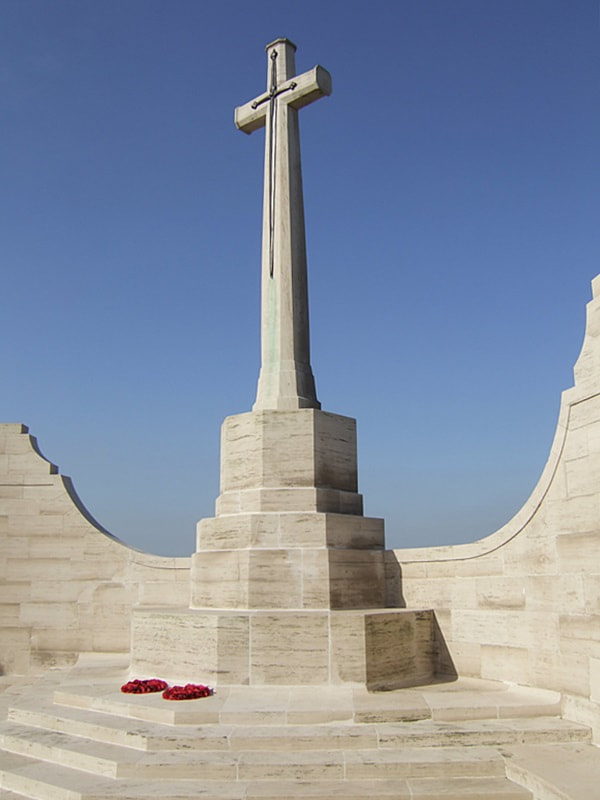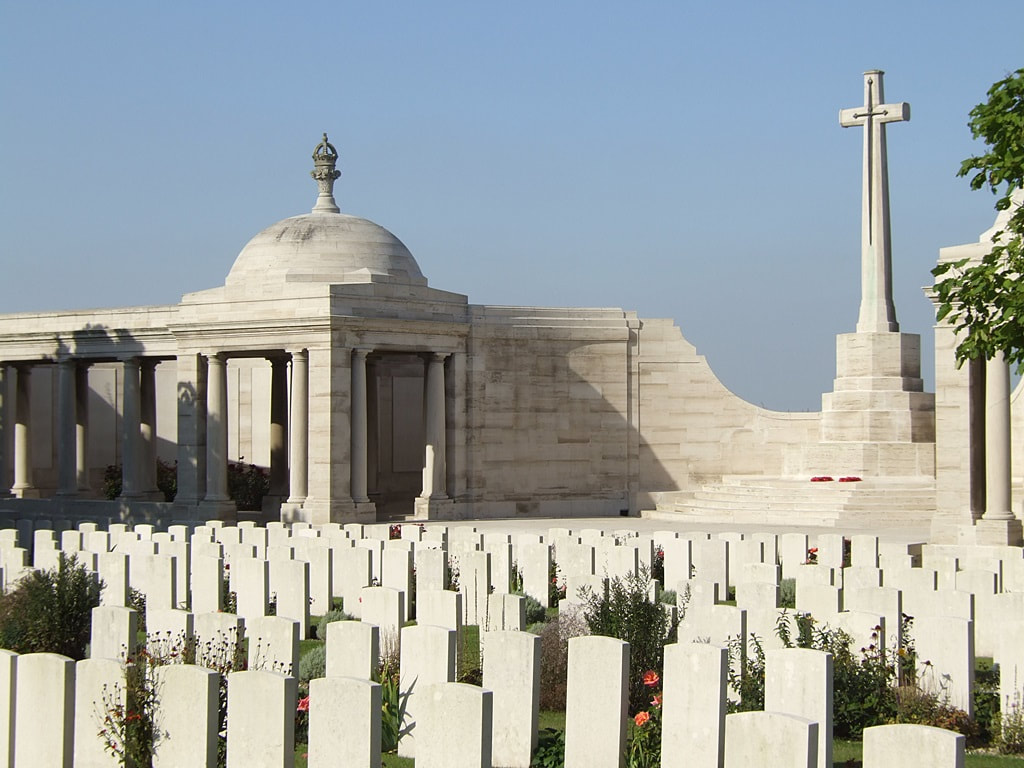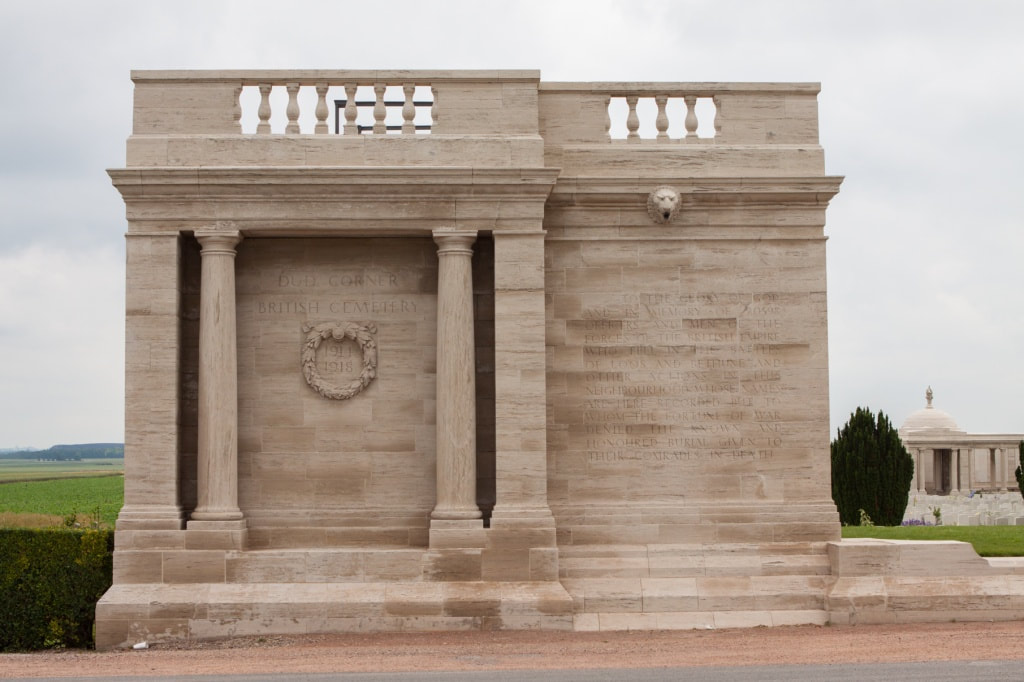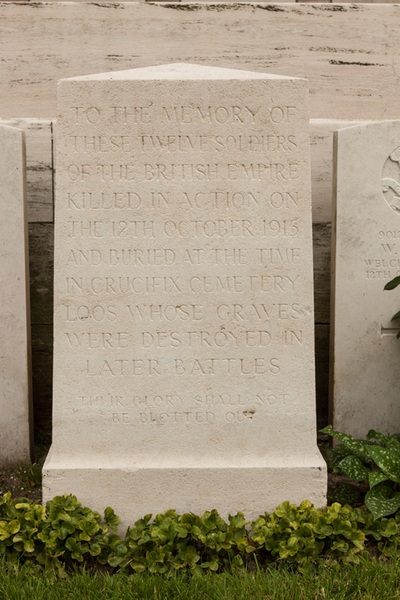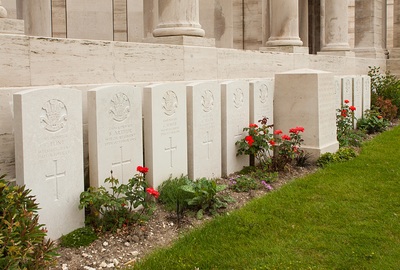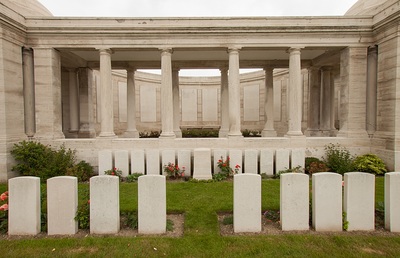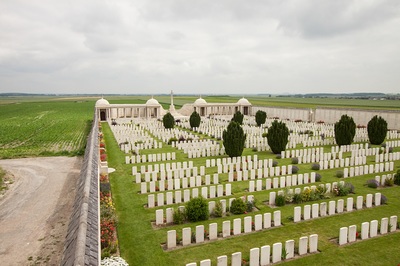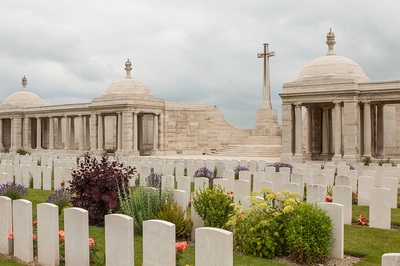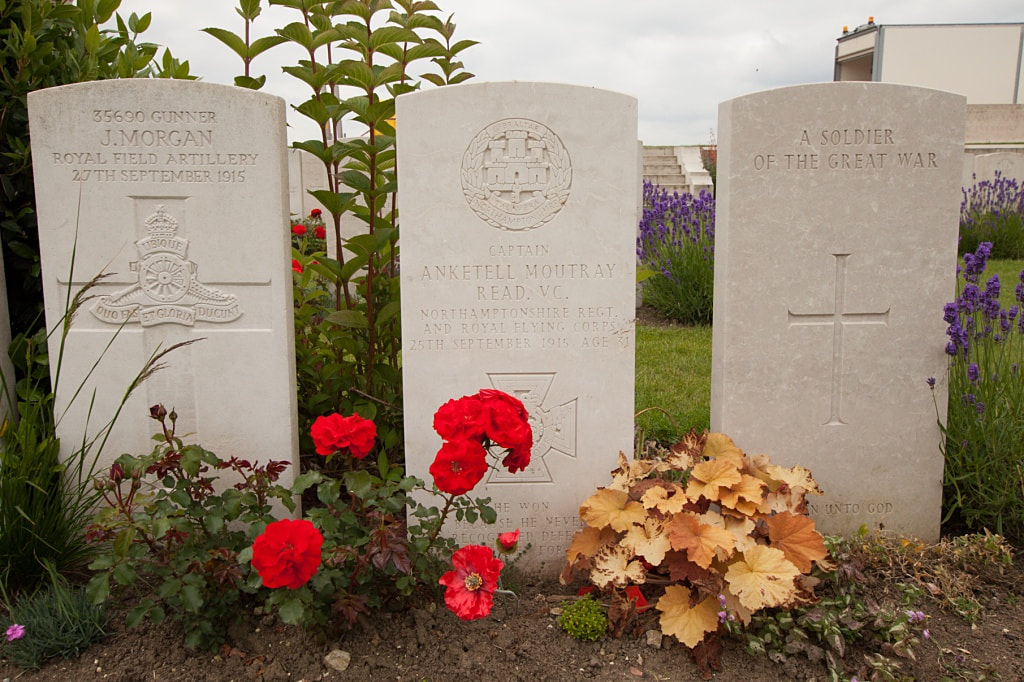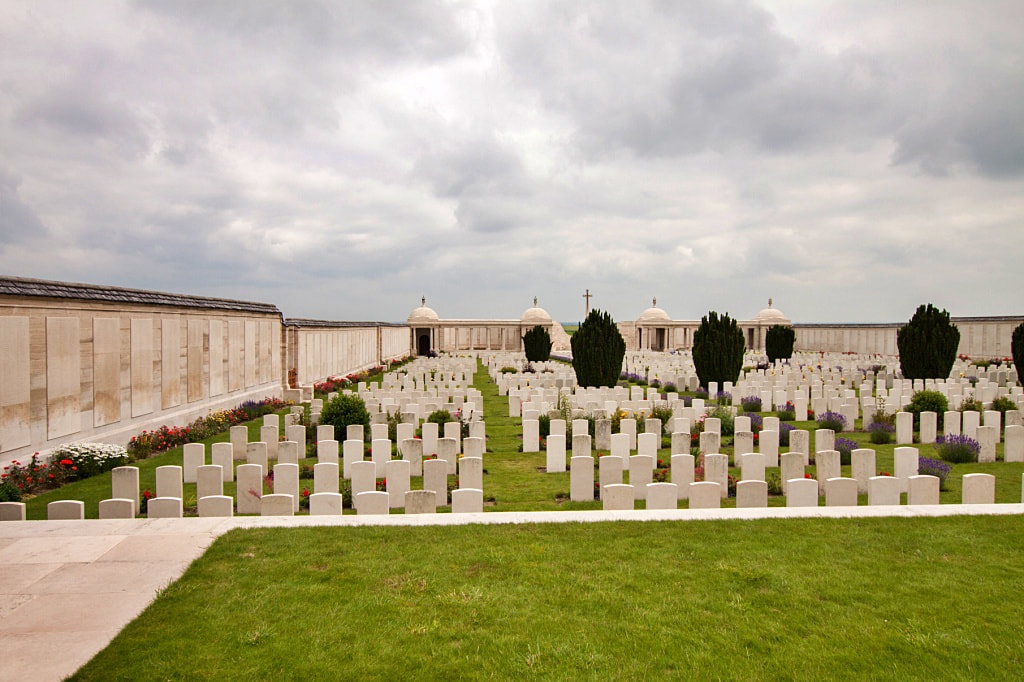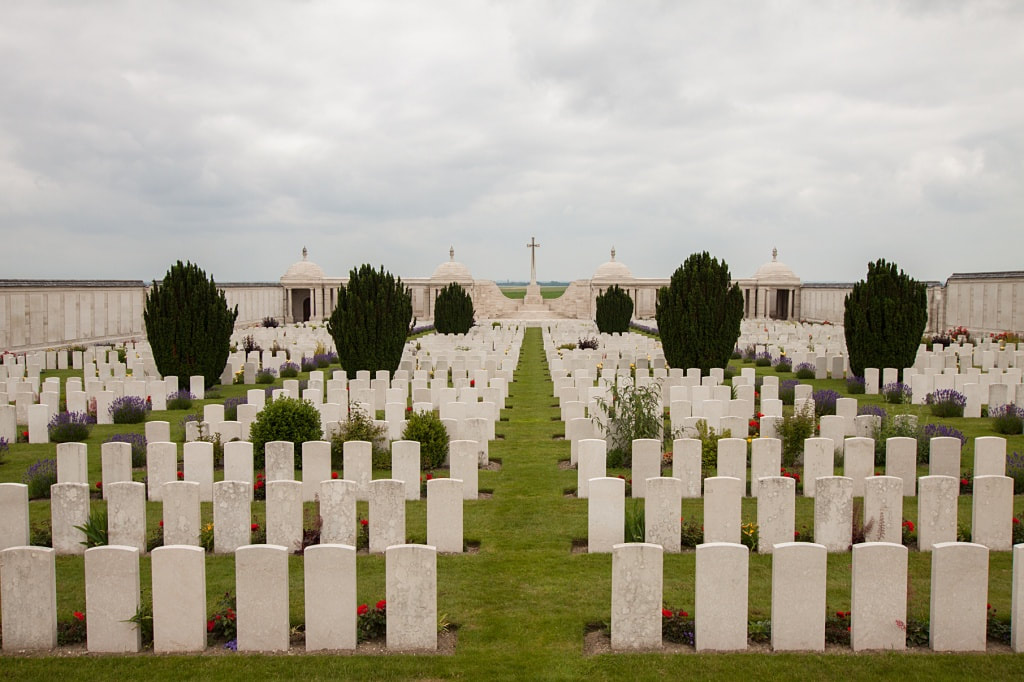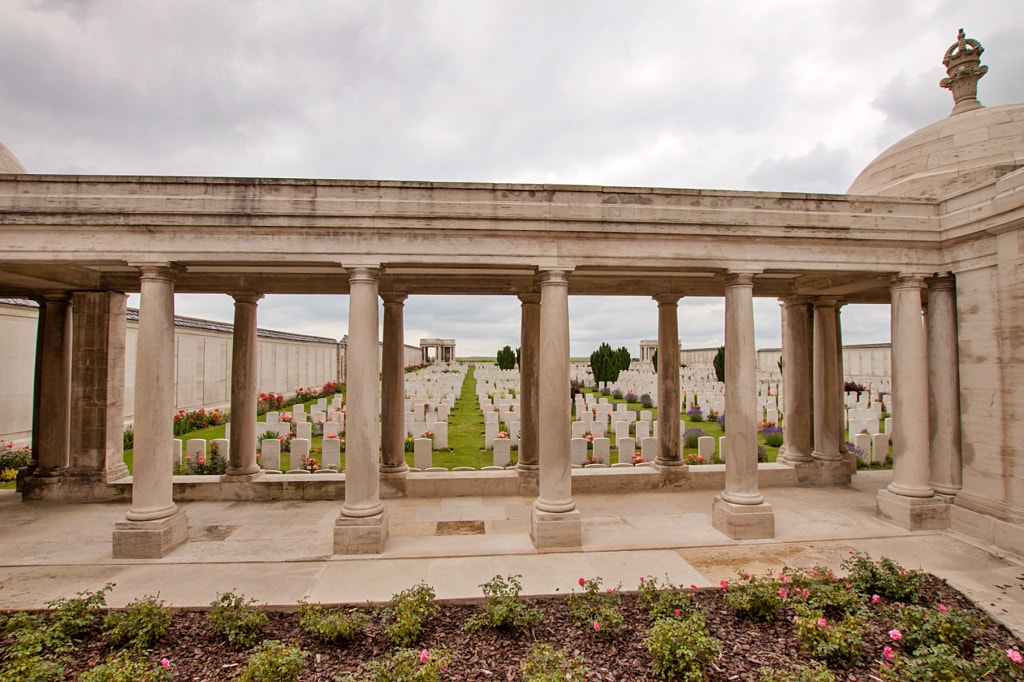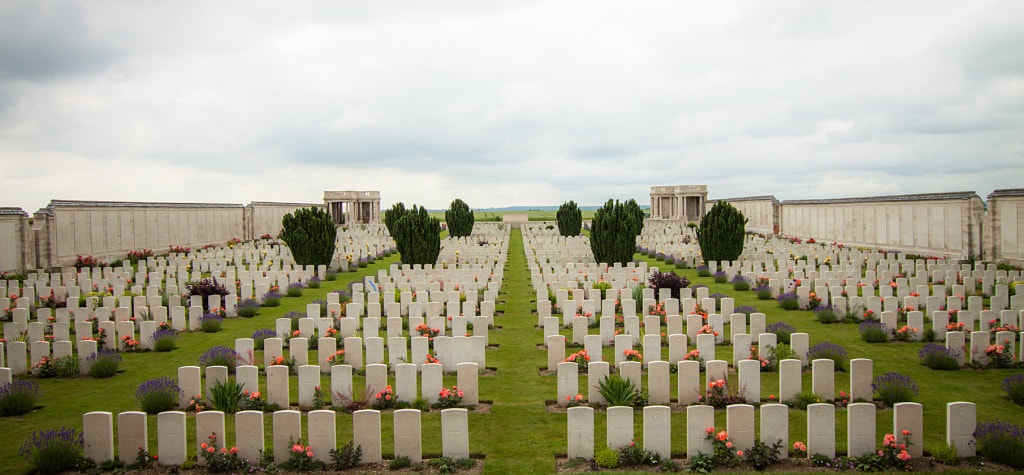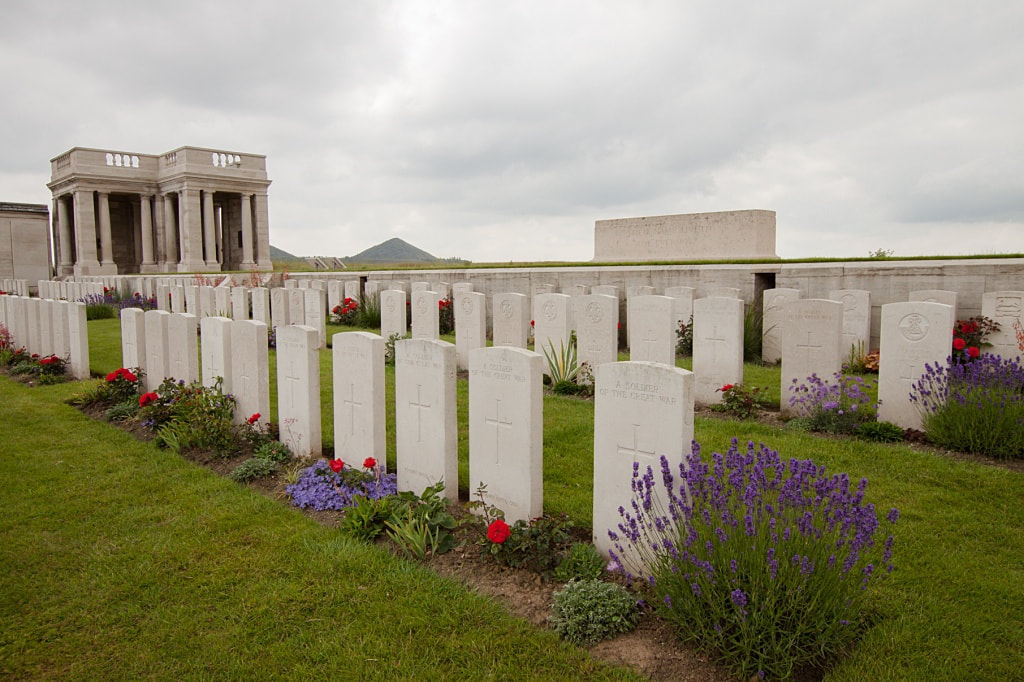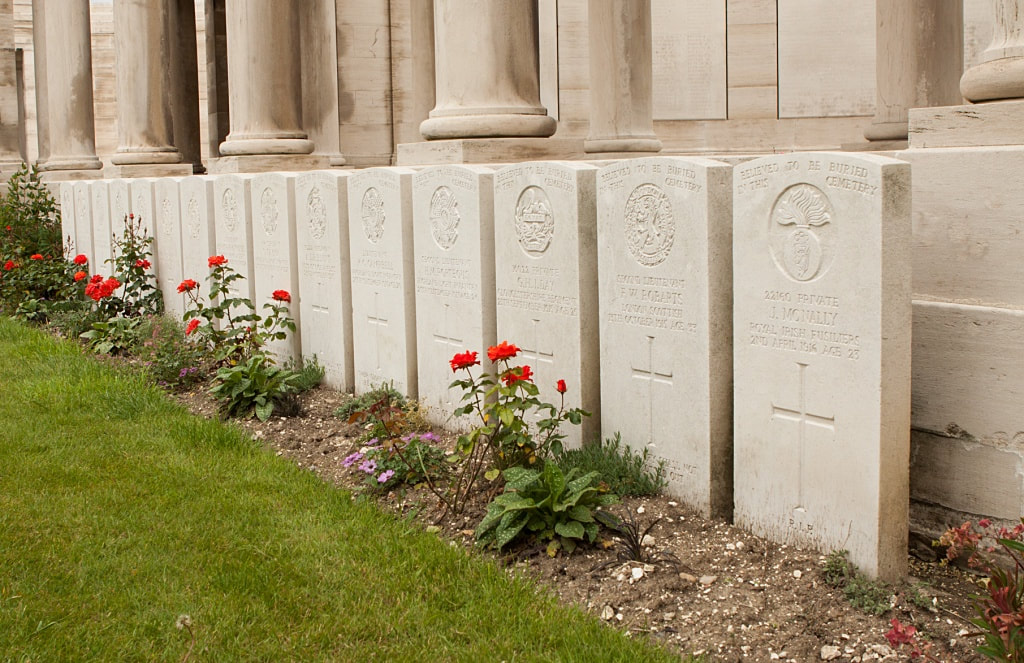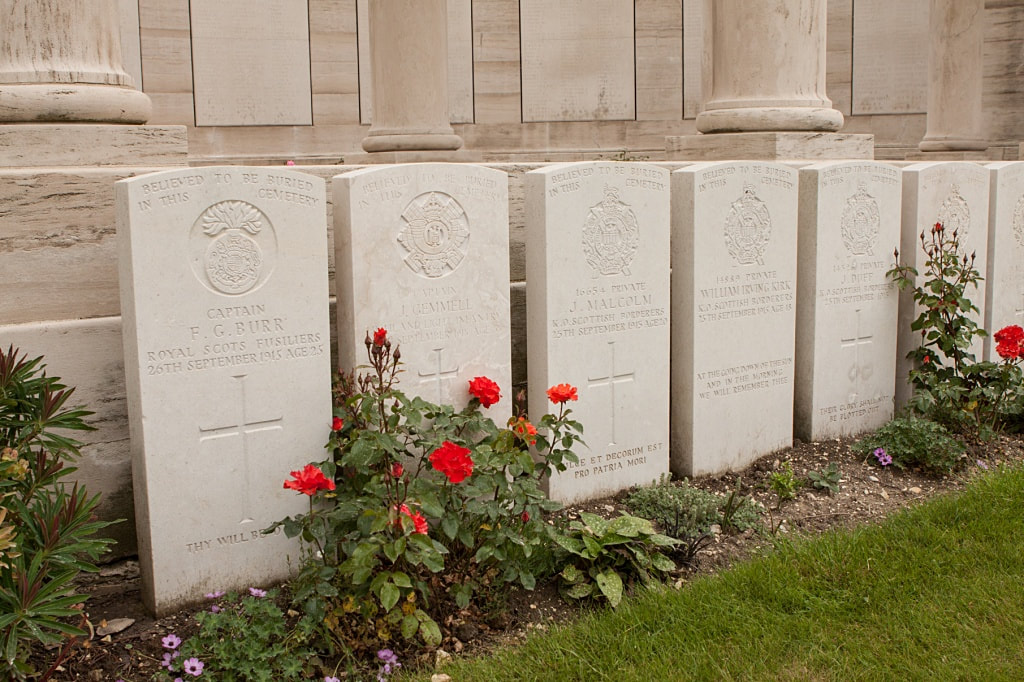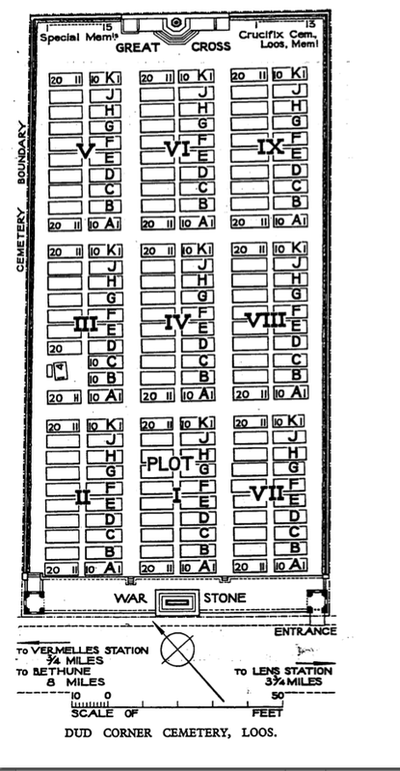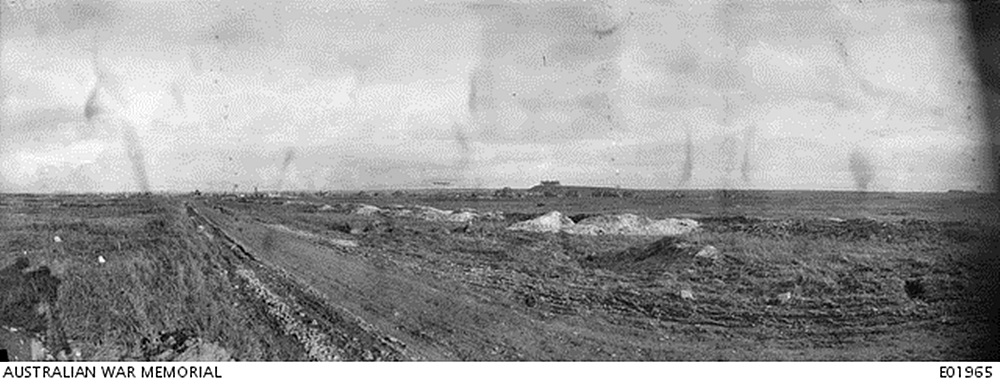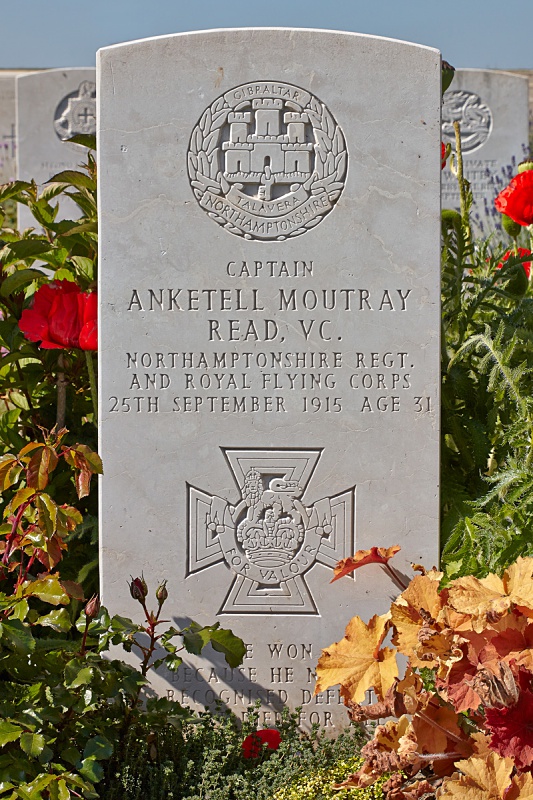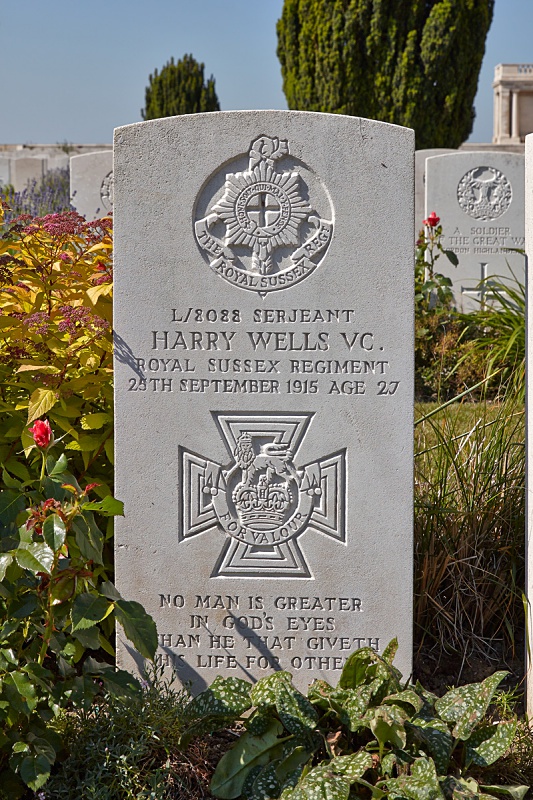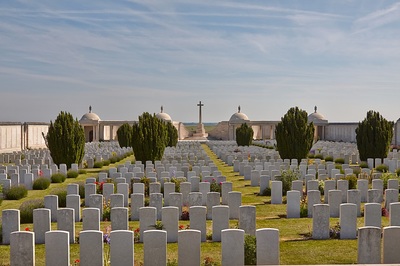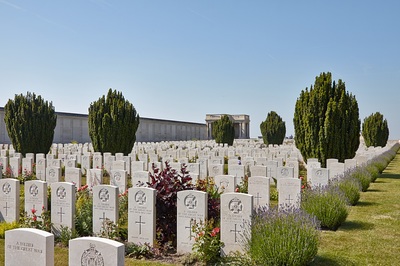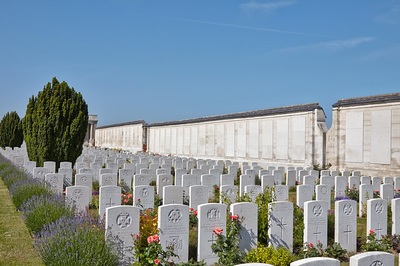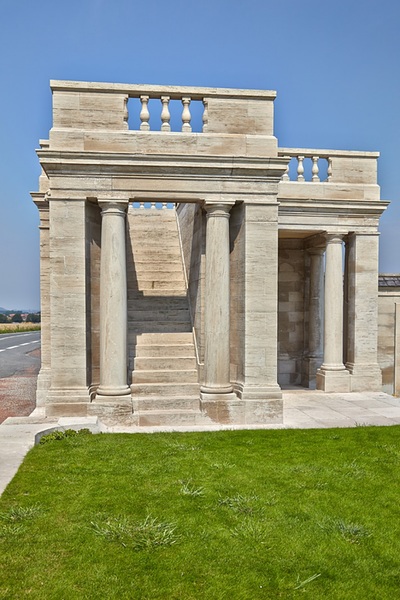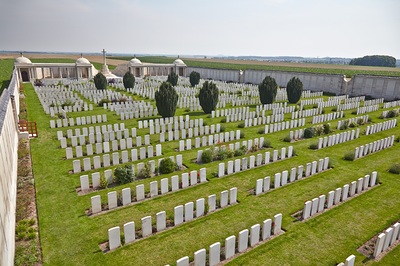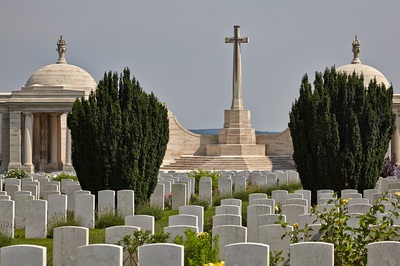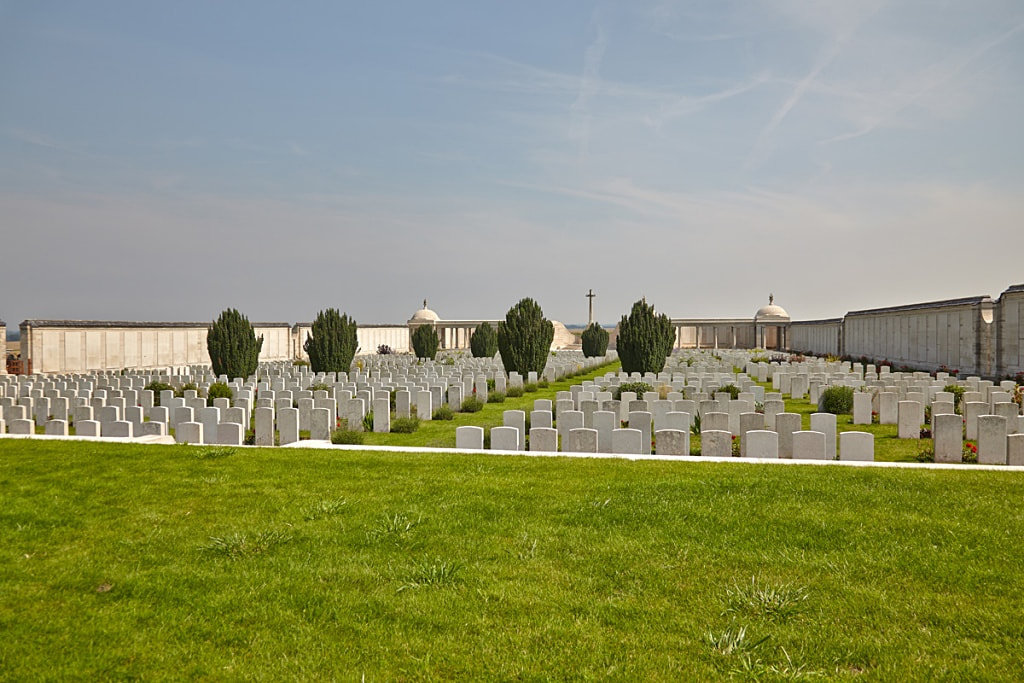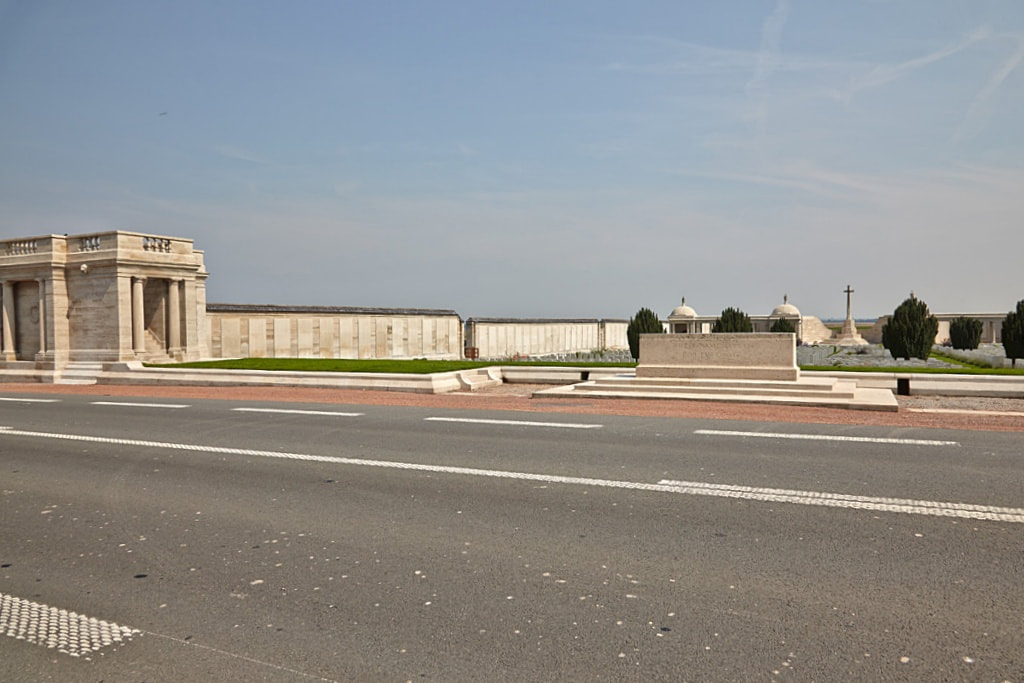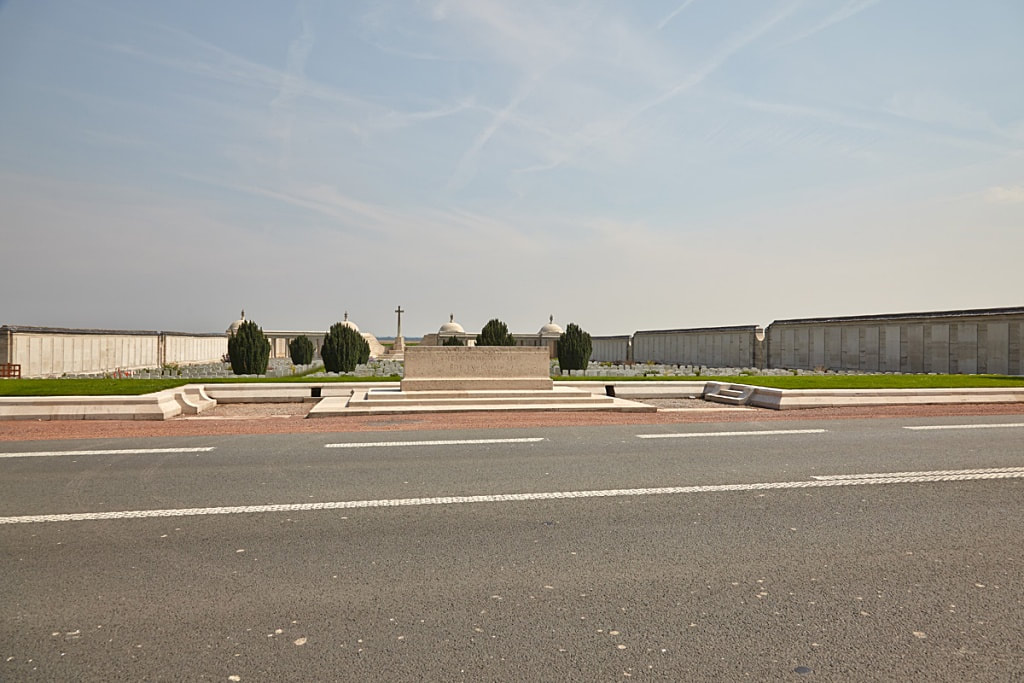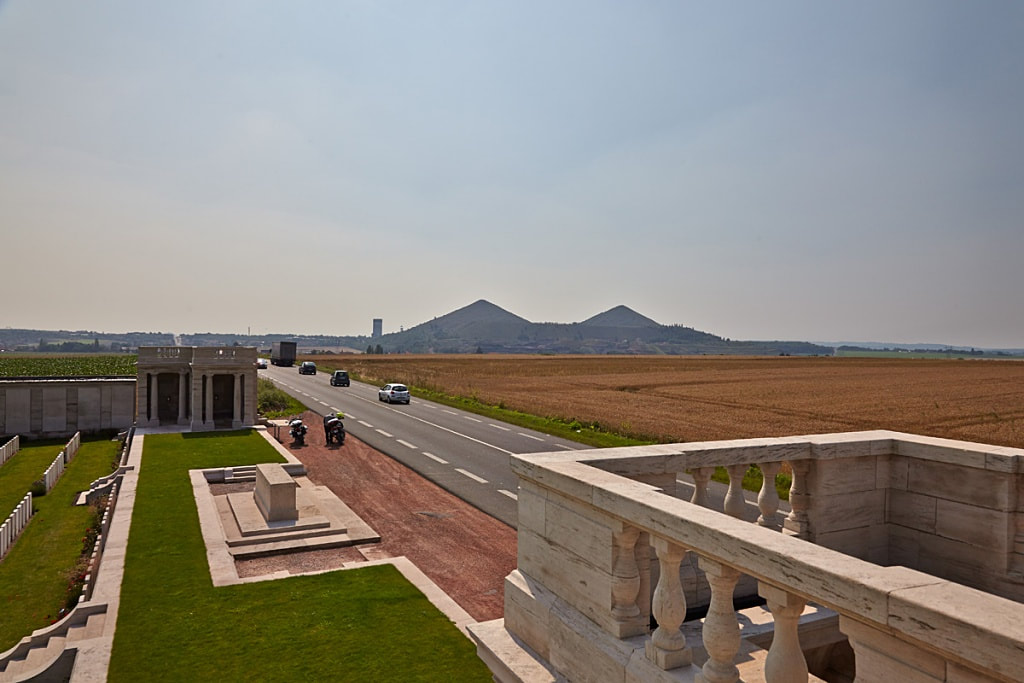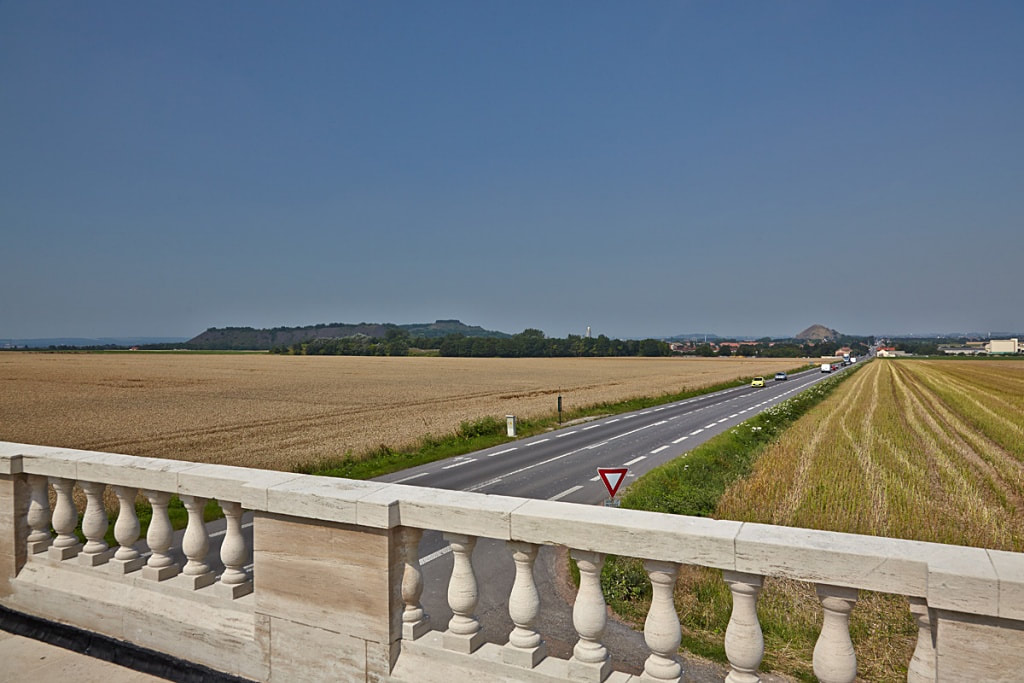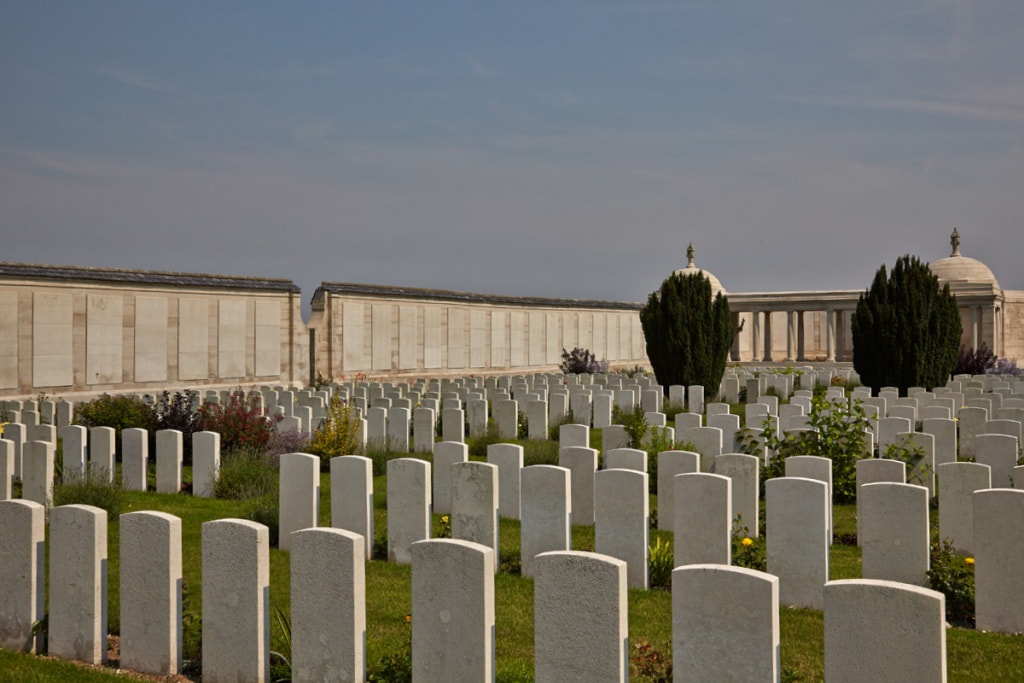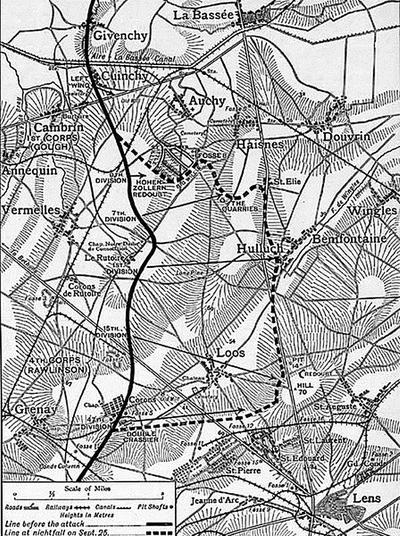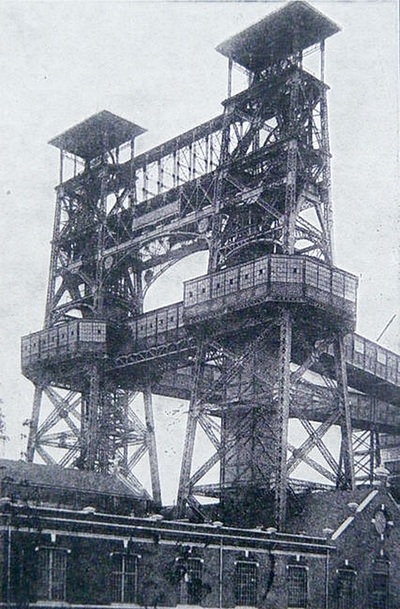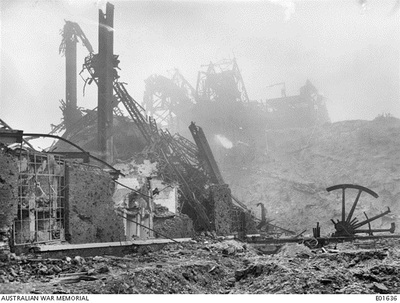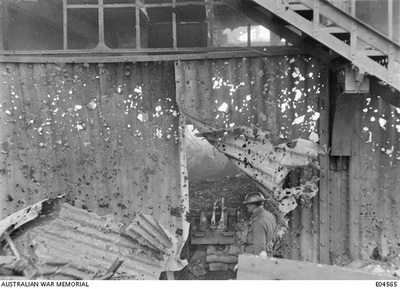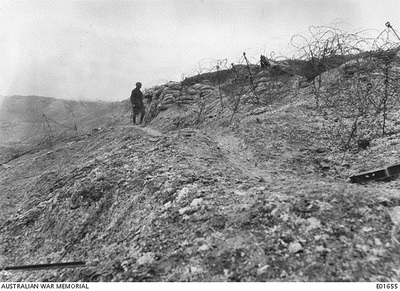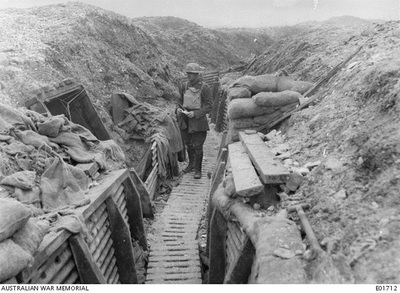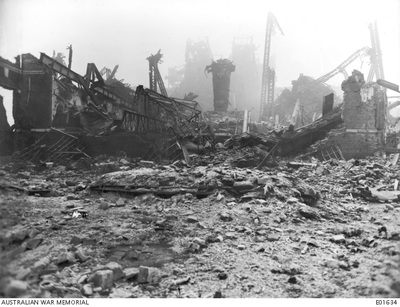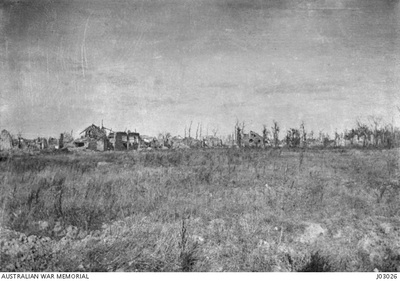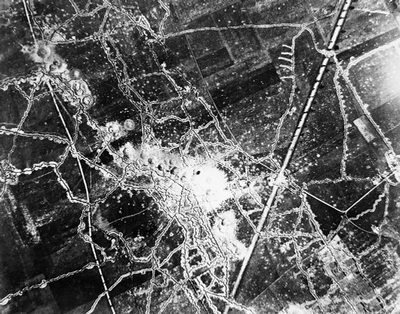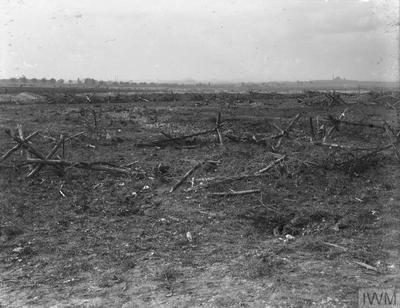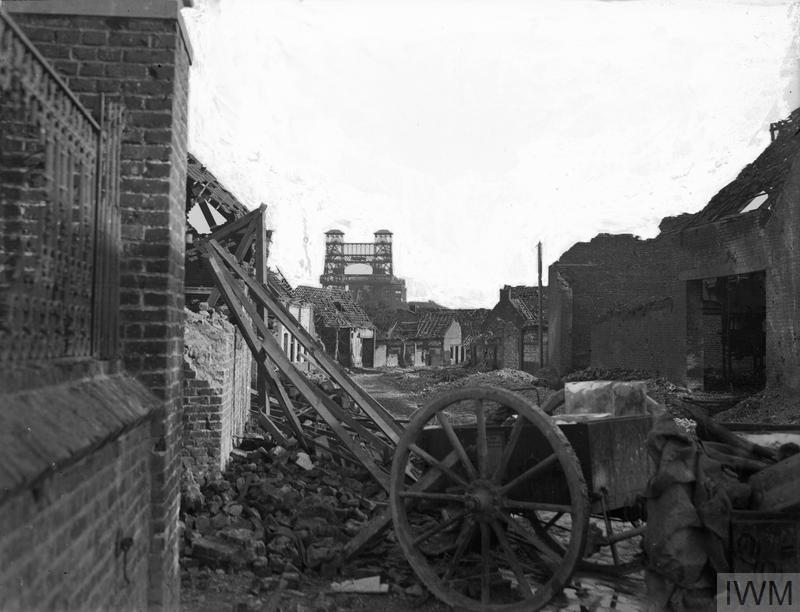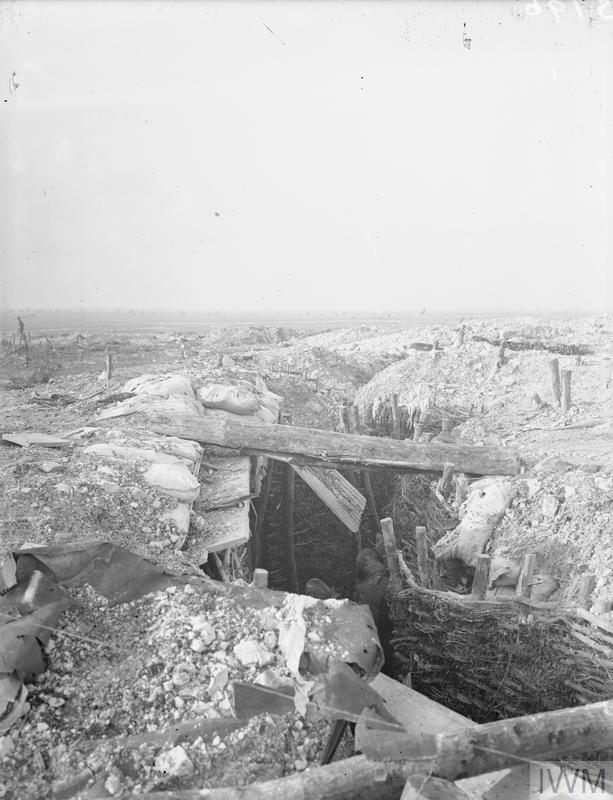DUD CORNER CEMETERY
Pas De Calais
France
GPS Coordinates Latitude: 50.461 Longitude: 2.77173
Location Information
Loos-en-Gohelle is a village 5 kilometres north-west of Lens. Dud Corner Cemetery is located about 1 kilometre west of the village, to the north-east of the D943 the main Lens to Bethune road.
The Loos Memorial forms the side and back of Dud Corner Cemetery and commemorates over 20,000 officers and men who have no known grave, who fell in the area from the River Lys to the old southern boundary of the First Army, east and west of Grenay.
Visiting Information
Wheelchair access to the cemetery is possible, but may be by alternative entrance.
Historical Information
The name "Dud Corner" is believed to be due to the large number of unexploded enemy shells found in the neighbourhood after the Armistice. The only burials here during hostilities were those of four Officers of the 9th Black Watch and one Private of the 8th Royal Dublin Fusiliers, close to Plot III, Row B; the remainder of the graves were brought in later from isolated positions near Loos and to the North, and from certain small cemeteries, including:-
TOSH CEMETERY, LOOS, was on the North side of the village, close to the communication trench called Tosh Alley. It contained the graves of 171 soldiers from the United Kingdom (118 of whom were Irish) and five from Canada. It was used from October 1915 to September 1917.
CRUCIFIX CEMETERY, LOOS, was a little West of Tosh Cemetery. It was used from September 1915 to May 1916, and it contained the graves of 53 soldiers from the United Kingdom.
LE RUTOIRE BRITISH CEMETERY, VERMELLES, was close to Le Rutoire Farm, which is on Loos Plain, near the village of Vermelles. It was used in 1915, and contained the graves of 82 soldiers from the United Kingdom and six French soldiers.
There are 1,812, 1914-18 war casualties commemorated in this site. Of these, 1,126 are unidentified and special headstones have been erected to 15 soldiers from the United Kingdom who are believed to be buried among them. The great majority of the dead buried here fell in the Battle of Loos 1915; but some were killed in succeeding years. Originally, the regimental memorials for the following units were brought into the cemetery:-
10th Scottish Rifles and the 17th London Regiment, dating from the Battle of Loos, and those of the Royal Montreal Regiment and the Royal Highlanders of Canada, dating from the Battle of Hill 70 in August 1917. These memorials were later removed.
Special memorials are erected in this Cemetery to twelve soldiers of the 2nd Welch Regiment, killed in action on the 12th October 1915, and originally buried in Crucifix Cemetery, Loos, whose graves could not be found on concentration.
The cemetery now covers an area of 5,550 square metres, and is bounded by a low rubble wall except on the road side, where the War Stone is raised on a grass terrace and flanked by buildings.
Total Burials: 1,812.
Identified Casualties: United Kingdom 670, Canada 16. Total 686.
Unidentified Casualties: 1,126.
Dedications
S/2181 Private William Thomas Coles, "C" Coy. 2nd Bn., Royal Sussex Regiment, 25th September 1915 aged 21. Eldest son of William and Rebecca Coles, of 8, Newmarket Rd., Brighton.
Remembered by Jim Type
Cemetery images in this gallery © Werner Van Caneghem
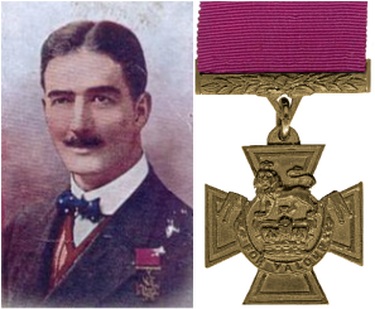
Captain
Anketell Moutray Read, V. C.
1st Bn. Northamptonshire Regiment (formerly Royal Flying Corps)
died on 25th September 1915, aged 31. Plot VII. F. 19.
Son of Col. J. Moutray Read, of Cheltenham, and of Mrs. E. Moutray Read, of 17, Albany Rd., St. Leonards-on-Sea.
Citation: An extract from "The London Gazette," No. 29371, dated 16th Nov., 1915, records the following:-"For most conspicuous bravery during the first attack near Hulluch on the morning of 25th September, 1915. Although partially gassed, Captain Read went out several times in order to rally parties of different units which were disorganised and retiring. He led them back into the firing line, and, utterly regardless of danger, moved freely about encouraging them under a withering fire. He was mortally wounded while carrying out this gallant work. Captain Read had previously shown conspicuous bravery during digging operations on 29th, 30th and 31st August, 1915, and on the night of the 29th-30th July he carried out of action an officer, who was mortally wounded, under a hot fire from rifles and grenades."
Anketell Moutray Read, V. C.
1st Bn. Northamptonshire Regiment (formerly Royal Flying Corps)
died on 25th September 1915, aged 31. Plot VII. F. 19.
Son of Col. J. Moutray Read, of Cheltenham, and of Mrs. E. Moutray Read, of 17, Albany Rd., St. Leonards-on-Sea.
Citation: An extract from "The London Gazette," No. 29371, dated 16th Nov., 1915, records the following:-"For most conspicuous bravery during the first attack near Hulluch on the morning of 25th September, 1915. Although partially gassed, Captain Read went out several times in order to rally parties of different units which were disorganised and retiring. He led them back into the firing line, and, utterly regardless of danger, moved freely about encouraging them under a withering fire. He was mortally wounded while carrying out this gallant work. Captain Read had previously shown conspicuous bravery during digging operations on 29th, 30th and 31st August, 1915, and on the night of the 29th-30th July he carried out of action an officer, who was mortally wounded, under a hot fire from rifles and grenades."
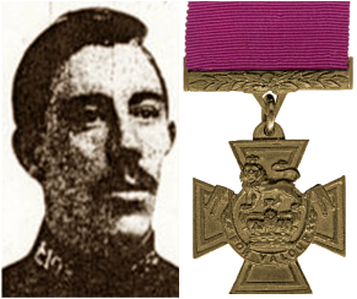
L/8088 Serjeant
Harry Wells, V. C.
2nd Bn. Royal Sussex Regiment
he was killed on 25th September 1915, aged 27. Plot V. E. 2.
Son of Samuel and Emma Wells. Born in Herne, Kent.
Citation: An extract from the "London Gazette," No. 29371, dated 16th Nov., 1915, records the following:- "When his Platoon Officer had been killed he took command and led his men forward to within fifteen yards of the German wire. Nearly half the Platoon were killed or wounded, and the remainder were much shaken, but with the utmost coolness and bravery, Serjeant Wells rallied them and led them forward. Finally, when very few were left, he stood up and urged them forward once more, but while doing this he was killed. He gave a magnificent example of courage and determination."
Harry Wells, V. C.
2nd Bn. Royal Sussex Regiment
he was killed on 25th September 1915, aged 27. Plot V. E. 2.
Son of Samuel and Emma Wells. Born in Herne, Kent.
Citation: An extract from the "London Gazette," No. 29371, dated 16th Nov., 1915, records the following:- "When his Platoon Officer had been killed he took command and led his men forward to within fifteen yards of the German wire. Nearly half the Platoon were killed or wounded, and the remainder were much shaken, but with the utmost coolness and bravery, Serjeant Wells rallied them and led them forward. Finally, when very few were left, he stood up and urged them forward once more, but while doing this he was killed. He gave a magnificent example of courage and determination."
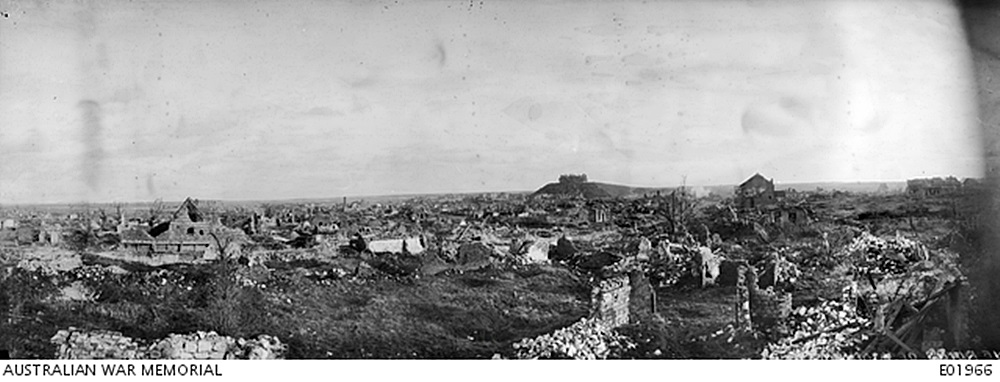
February 1918: A view of the ruins of Loos showing the extent of the destruction wrought by the years of bombardment to which the town was subjected. Beyond the coal mine to the right is the famous Hill 70, in the capture of which the 3rd Australian Tunnelling Company was associated with the Canadians.
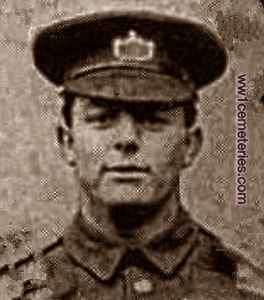
13334 Serjeant
Ernest Linden Howard Betteridge
10th Bn. Gloucestershire Regiment
25th September 1915, aged 24.
Plot VII. D. 1.
Son of Richard and Mary Betteridge, of 36, Hatherley St., Tivoli, Cheltenham.
His headstone bears the inscription; "God is Love."
Ernest Linden Howard Betteridge
10th Bn. Gloucestershire Regiment
25th September 1915, aged 24.
Plot VII. D. 1.
Son of Richard and Mary Betteridge, of 36, Hatherley St., Tivoli, Cheltenham.
His headstone bears the inscription; "God is Love."
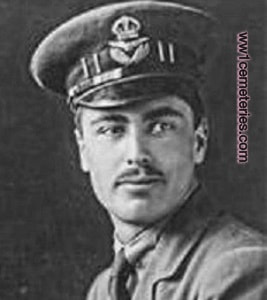
Captain
Philip Scot Burge, M. C., M. M.
Royal Air Force
24th July 1918, aged 23.
Plot I. C. 1.
Son of William A. and Grace Burge, of 82, Holbein House, Sloane Square, London. Native of Potters Bar, Middlesex.
His headstone bears the inscription; "Dearly loved fifth son of William A. and Grace Burge."
Philip Scot Burge, M. C., M. M.
Royal Air Force
24th July 1918, aged 23.
Plot I. C. 1.
Son of William A. and Grace Burge, of 82, Holbein House, Sloane Square, London. Native of Potters Bar, Middlesex.
His headstone bears the inscription; "Dearly loved fifth son of William A. and Grace Burge."
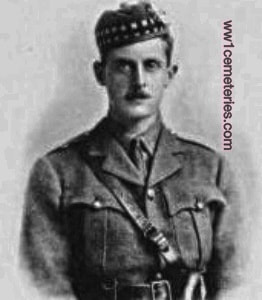
Captain
Frederick Godfrey Burr
"A" Coy. 7th Bn. Royal Scots Fusiliers
26th September 1915, aged 25.
Special Memorial 1.
Son of Frederick William and Euphemia Burr, of "Gorse Hill," Denton Rd., Eastbourne. Native of Horsmonden, Kent.
Frederick Godfrey Burr
"A" Coy. 7th Bn. Royal Scots Fusiliers
26th September 1915, aged 25.
Special Memorial 1.
Son of Frederick William and Euphemia Burr, of "Gorse Hill," Denton Rd., Eastbourne. Native of Horsmonden, Kent.
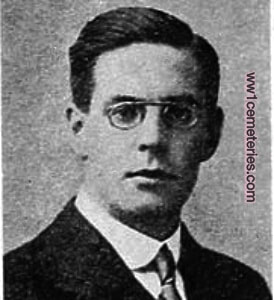
Second Lieutenant
George Macbeth Calder
8th Bn. Seaforth Highlanders
25th September 1915, aged 24.
Plot V. H. 1.
Son of George Macbeth Calder and Isabella Calder, of Presley Cottage, Dunphail, Morayshire. M.A. (Aberdeen), Medical Student.
George Macbeth Calder
8th Bn. Seaforth Highlanders
25th September 1915, aged 24.
Plot V. H. 1.
Son of George Macbeth Calder and Isabella Calder, of Presley Cottage, Dunphail, Morayshire. M.A. (Aberdeen), Medical Student.
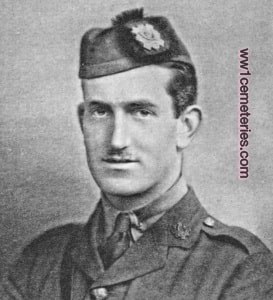
Lieutenant
Kenneth Gordon Campbell
12th Bn. Highland Light Infantry
25th September 1915, aged 20.
Special Memorial 11.
Son of Gordon and Blanche Campbell, of The Thatched Cottage, Brundall, Norwich. Native of Cambridge.
Kenneth Gordon Campbell
12th Bn. Highland Light Infantry
25th September 1915, aged 20.
Special Memorial 11.
Son of Gordon and Blanche Campbell, of The Thatched Cottage, Brundall, Norwich. Native of Cambridge.
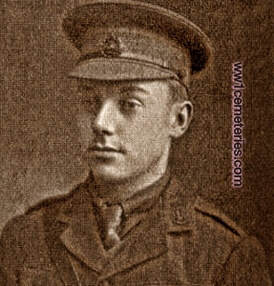
Lieutenant
Robert Leslie Carpenter
1st/17th Bn. London Regiment
26th October 1915, aged 20.
Plot III. A. 8.
Son of Robert Arthur and Eliza Jane Carpenter, of St. Leonards-on-Sea. Born at Margate, Kent.
His parents added the following inscription to his headstone; "An only son, "To what purpose is this waste?" S.Matt.26.8."
Robert Leslie Carpenter
1st/17th Bn. London Regiment
26th October 1915, aged 20.
Plot III. A. 8.
Son of Robert Arthur and Eliza Jane Carpenter, of St. Leonards-on-Sea. Born at Margate, Kent.
His parents added the following inscription to his headstone; "An only son, "To what purpose is this waste?" S.Matt.26.8."
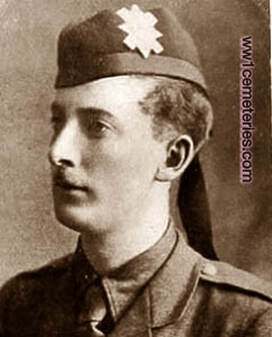
Lieutenant
John Crighton
"A" Coy. 9th Bn. Black Watch (Royal Highlanders)
25th September 1915, aged 23.
Plot I. G. 9.
Son of John and Helen Crighton, of 4, Lammerton Terrace, Dundee.
The inscription on his headstone reads; "I thank God for every remembrance of him."
John Crighton
"A" Coy. 9th Bn. Black Watch (Royal Highlanders)
25th September 1915, aged 23.
Plot I. G. 9.
Son of John and Helen Crighton, of 4, Lammerton Terrace, Dundee.
The inscription on his headstone reads; "I thank God for every remembrance of him."
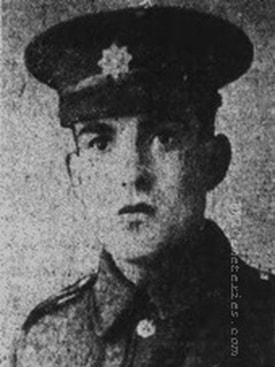
14730 Private
Harry Howarth
8th Bn. Devonshire Regiment
25th September 1915, aged 24.
Plot VIII. E. 16.
Son of Mary A. Howarth, of 24, Oat St., Padiham, Burnley.
Harry Howarth
8th Bn. Devonshire Regiment
25th September 1915, aged 24.
Plot VIII. E. 16.
Son of Mary A. Howarth, of 24, Oat St., Padiham, Burnley.
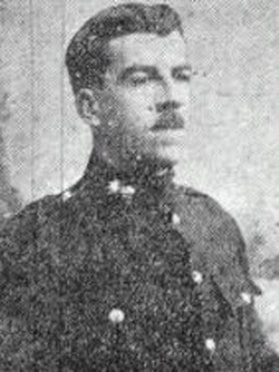
Company Serjeant Major
James T. Leahy
2nd Bn. Royal Munster Fusiliers
25th September 1915
Plot VII. E. 11.
Eldest son of William D. Leahy (late Postal Telegraphic Service, G.P.O., Cork.) He is mentioned in 'The 2nd Munsters in France,' by Captain Jervis. He died attempting to rescue Maj J. W. Considine.
Picture courtesy of great nephew David Ellis
James T. Leahy
2nd Bn. Royal Munster Fusiliers
25th September 1915
Plot VII. E. 11.
Eldest son of William D. Leahy (late Postal Telegraphic Service, G.P.O., Cork.) He is mentioned in 'The 2nd Munsters in France,' by Captain Jervis. He died attempting to rescue Maj J. W. Considine.
Picture courtesy of great nephew David Ellis
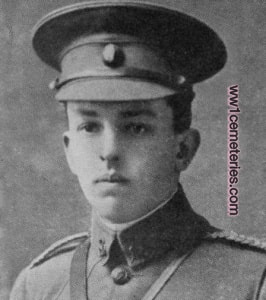
Captain
Guy Charles Boileau Willock
18th Bn. London Regiment (London Irish Rifles)
25th September 1918, aged 23.
Plot IX. D. 11.
Son of Charles Johnston Willock and the late Eleanor Maud Willock.
His father would later add the following inscription to his headstone; "Shot while leading his men over the top "He was loved by all who knew him a brave soldier and a gallant gentleman of never failing cheerfulness & contemptuous of danger" "Peace, peace, he is not dead he doth not sleep he hath awakened from the dream of life."
Guy Charles Boileau Willock
18th Bn. London Regiment (London Irish Rifles)
25th September 1918, aged 23.
Plot IX. D. 11.
Son of Charles Johnston Willock and the late Eleanor Maud Willock.
His father would later add the following inscription to his headstone; "Shot while leading his men over the top "He was loved by all who knew him a brave soldier and a gallant gentleman of never failing cheerfulness & contemptuous of danger" "Peace, peace, he is not dead he doth not sleep he hath awakened from the dream of life."
Picture gallery below © Geerhard Joos
Although many observers view the British successes at the Battle of Loos with cynicism, Major-General Richard Hilton, at that time a Forward Observation Officer, said of the battle in Philip Warner's 1976 book, The Battle of Loos (Wordsworth):
"A great deal of nonsense has been written about Loos. The real tragedy of that battle was its nearness to complete success. Most of us who reached the crest of Hill 70, and survived, were firmly convinced that we had broken through on that Sunday, 25th September 1915. There seemed to be nothing ahead of us, but an unoccupied and incomplete trench system. The only two things that prevented our advancing into the suburbs of Lens were, firstly, the exhaustion of the "Jocks" themselves (for they had undergone a bellyfull of marching and fighting that day) and, secondly, the flanking fire of numerous German machine-guns, which swept that bare hill from some factory buildings in Cite St. Auguste to the south of us. All that we needed was more artillery ammunition to blast those clearly-located machine-guns, plus some fresh infantry to take over from the weary and depleted "Jocks." But, alas, neither ammunition nor reinforcements were immediately available, and the great opportunity passed."
"A great deal of nonsense has been written about Loos. The real tragedy of that battle was its nearness to complete success. Most of us who reached the crest of Hill 70, and survived, were firmly convinced that we had broken through on that Sunday, 25th September 1915. There seemed to be nothing ahead of us, but an unoccupied and incomplete trench system. The only two things that prevented our advancing into the suburbs of Lens were, firstly, the exhaustion of the "Jocks" themselves (for they had undergone a bellyfull of marching and fighting that day) and, secondly, the flanking fire of numerous German machine-guns, which swept that bare hill from some factory buildings in Cite St. Auguste to the south of us. All that we needed was more artillery ammunition to blast those clearly-located machine-guns, plus some fresh infantry to take over from the weary and depleted "Jocks." But, alas, neither ammunition nor reinforcements were immediately available, and the great opportunity passed."
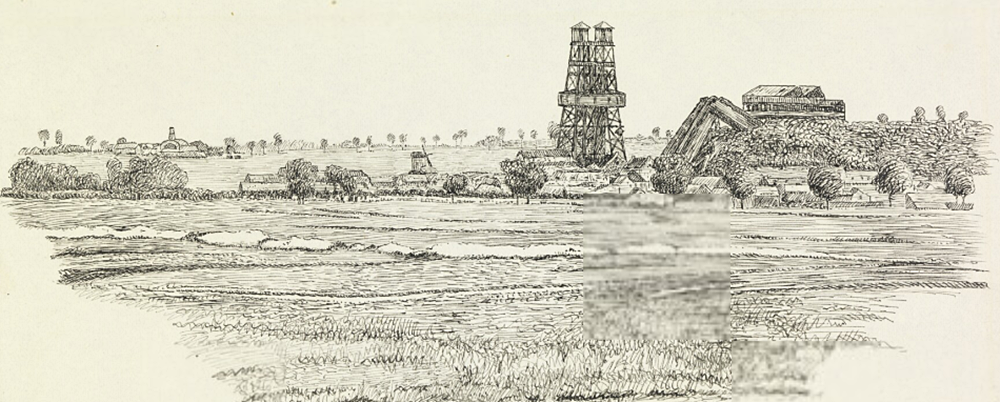
A view across to the distinctive mining village of Loos, dominated in the centre middle ground by the looming metal pit-head, known colloquially as 'Tower Bridge'. There are further mining structures to the right, all surrounded by houses and with a windmill in the centre left. The flat landscape in the immediate foreground is criss-crossed by a network of trenches. Drawn by Geoffrey K. Rose.
© IWM (Art.IWM ART 4801)
Decoding the Epitaphs of the Great War
Images and text by Lucy Betteridge-Dyson
@LMBD1418
ohwhataladylikewar.com
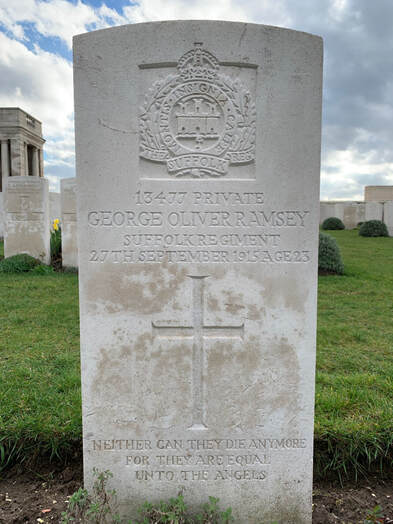
Neither can they die anymore
for they are equal
unto the angels
Private Ramsey’s epitaph, chosen by his Father, is taken from the bible, Luke 20:36
‘Neither can they die any more: for they are equal unto the angels; and are the children of God, being the children of the resurrection.’
It is interesting that Private Ramsey’s Father did not choose to alter this quotation to directly reference his son by changing ‘they’ to ‘he’ as many of the bereaved did. By choosing a quote that includes collective nouns there is perhaps an acknowledgement of the wider impact of the war and we see not only an epitaph for his son, but for all those who suffered and died as a result of the war.
13477 Private, George Oliver Ramsey, 9th Bn. Suffolk Regiment, 27th September 1915, aged 23.
for they are equal
unto the angels
Private Ramsey’s epitaph, chosen by his Father, is taken from the bible, Luke 20:36
‘Neither can they die any more: for they are equal unto the angels; and are the children of God, being the children of the resurrection.’
It is interesting that Private Ramsey’s Father did not choose to alter this quotation to directly reference his son by changing ‘they’ to ‘he’ as many of the bereaved did. By choosing a quote that includes collective nouns there is perhaps an acknowledgement of the wider impact of the war and we see not only an epitaph for his son, but for all those who suffered and died as a result of the war.
13477 Private, George Oliver Ramsey, 9th Bn. Suffolk Regiment, 27th September 1915, aged 23.

